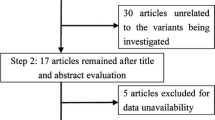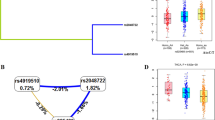Abstract
Genetic polymorphisms have shown to be susceptibility factors playing an important role in the development of most cancers. Nevertheless, as far as we know, only few studies have been conducted linking thyroid cancer incidence and GST polymorphisms, and no data are available on the possible association between NAT2 polymorphisms and thyroid cancer risk. The possible relationship between polymorphism at the GSTM1, GSTT1, GSTP1, and NAT2 genes and increased susceptibility to thyroid cancer has been evaluated in 176 thyroid cancer patients and 167 healthy controls, all from the urban district of Barcelona (Spain). The results indicate a clear role of the C481T change, present in several NAT2*5 alleles [odds ratio (OR)=0.58; 95% confidence interval (95% CI)=0.35–0.98]. Thus, those individuals carrying this change are less prone to develop thyroid cancer, mainly of the papillary type. In addition, there is a tendency towards the over-representation of the GSTM1 null genotype among thyroid cancer patients, particularly in those patients with papillary type tumor. The same is observed for the GSTM1 and GSTT1 null genotypes combination, and for other combinations with different NAT2 polymorphisms. The combinations involving the NAT2*6 and NAT2*7 genotypes showed the most important effect, and individuals carrying both alleles present a higher risk of thyroid cancer (OR=7.36; 95% CI=0.85− 63.47), mainly for the follicular type (OR=17.94; 95% CI=1.34–238.70). The combination of NAT2*5 with NAT2*7 was also found to increase 5.26 (95% CI=1.07–25.76) times the risk of thyroid cancer. In conclusion, our results show that NAT2 polymorphisms play a significant role in thyroid cancer risk modulation.
Similar content being viewed by others
References
Lichtenstein P, Holm NV, Verkasalo PK, et al. Environmental and heritable factors in the causation of cancer—analyses of cohorts of twins from Sweden, Denmark, and Finland. New England J Med 2000,343: 78–85.
Ministerio de Sanidad y Consumo (MSC). La situación del cáncer en España, Publicaciones del Ministerio de Sanidad y Consumo 2005 p. 88.
Leenhardt L, Grosclaude P, Cherie-Challine L; Thyroid Cancer Committee. Increased incidence of thyroid carcinome in France: a true epidemic or thyroid nodule management effects? Report from the French Thyroid Cancer Committee. Thyroid 2004, 14: 1056–60.
Akslen LA, Haldorsen T, Thoresen SO, Glattre E. Survival and causes of death in thyroid cancer: a population-based study of 2479 cases from Norway. Cancer Res 1991, 51: 1234–41.
Robbins J, Merino MJ, Boice JD Jr, et al. Thyroid cancer: a lethal endocrine neoplasm. Ann Intern Med 1991, 115: 133–47.
Ron E, Modan B. Thyroid. In: Schottenfeld D, Fraumeni J, eds. Cancer epidemiology and prevention. Philadelphia: WB Saunders. 1982, 837–54.
Kingman S. Thyroid cancer rises after Chernobyl. BMJ 1992, 305: 601–2.
Haselkorn T, Stewart SL, Horn-Ross PL. Why are thyroid cancer rates so high in Southeast Asian women living in the United States? The Bay Area thyroid cancer study. Cancer Epidemiol Biomarkers Prev 2003, 12: 144–50.
Galanti MR, Sparén P, Karlsson A, Grimelius L, Ekbom A. Is residence in areas of endemic goiter a risk factor for thyroid cancer? Int J Cancer 1995, 61: 615–21.
Steenland K, Cedillo L, Tucker J, et al. Thyroid hormones and cytogenetic outcomes in backpack sprayers using ethylenebis(dithio-carbamate) (EBCD) fungicides in Mexico. Environ Health Perspect 1997,105: 1126–30.
Wingren GB, Axelson O. Occupational and environmental determinants for benign thyroid disease and follicular thyroid cancer. Int J Occup Environ Health 1997, 3: 89–94.
Autrup H. Genetic polymorphisms in human xenobiotic metabolizing enzymes as susceptibility factors in toxic response. Mutat Res 2000, 464: 65–76.
Landi S. Mammalian class theta GST and differential susceptibility to carcinogens: a review. Mutat Res 2000, 463: 247–83.
Taningher M, Malacarne D, Izzotti A, Ugolini D, Parodi S. Drug metabolism polymorphisms as modulators of cancer susceptibility. Mutat Res 1999, 436: 227–61.
Vineis P. The relationship between polymorphisms of xenobiotic metabolizing enzymes and susceptibility to cancer. Toxicology 2003,181-182: 457–62.
Morari EC, Leite JLP, Granja F, Assumpçao LVM, Ward LS. The null genotype of glutathione S-transfererase M1 and T1 locus increases the risk for thyroid cancer. Cancer Epidemiol Biomarkers Prev 2002,11: 1485–8.
Granja F, Morari J, Morari EC, Correa LAC, Assumpçao LVM, Ward LS. GST profiling may be useful in the screening for thyroid nodule malignancy. Cancer Lett 2004, 209: 129–37.
Canbay E, Dokmetas S, Canbay EI, Sen M Bardakci F. Higher glutathione transferase GSTM1 0/0 genotype frequency in young thyroid carcinoma patients. Curr Med Res Opin 2003, 19: 102–6.
Hernández A, Céspedes W, Xamena N, et al. Glutathione S-trans-ferase polymorphisms in thyroid cancer patients. Cancer Lett 2003, 190: 37–44.
Gaspar J, Rodrigues S, Gil OM, et al. Combined effects of glutathione S-transferase polymorphisms and thyroid cancer risk. Cancer Genet Cytogenet 2004, 151: 60–7.
Stankov K, Landi S, Gioia-Patricola L, et al. GSTT1 and M1 polymorphisms in Hürthle thyroid cancer patients. Cancer Lett 2006, 240: 76–82.
Nedelcheva Kristensen V, Andersen TI, Erikstein B, et al. Single tube multiplex polymerase chain reaction genotype analysis of GSTM1, GSTT1 and GSTP1: relation of genotypes to TP53 tumor status and clinicopathological variables in breast cancer patients. Pharmacogenetics 1998, 8: 441–7.
Hein DW, Doll MA, Fretland AJ, et al. Molecular genetics and epidemiology of the NAT1 and NAT2 acetylation polymorphisms. Cancer Epidemiol Biomarkers Prev 2000, 9: 29–42.
Wacholder S, Chanock S, Garcia-Closas M, El Ghormli L, Rothman N. Assessing the probability that a positive report is false: an approach for molecular epidemiology studies. J Natl Cancer Inst 2004, 96: 434–42.
Lin D, Meyer DJ, Ketterer B, Lang NP, Kadlubar FF. Effects of human and rat glutathione S-transferases on the covalent DNA binding of the N-acetoxy derivatives of heterocyclic amine carcinogens in vitro: a possible mechanism of organ specificity in their carcinogenesis. Cancer Res 1994, 54: 4920–6.
Mulders TM, Keizer HJ, Breimer DD Mulder GJ. In vivo characterization and modulation of the glutathione/glutathione S-transferase system in cancer patients. Drug Metab Rev 1995, 27: 191–229.
Harris MJ, Coggan M, Langton L, Wilson SR, Board PG. Polymorphisms of the Pi class glutathione S-transferase in normal populations and cancer patients. Pharmacogenetics 1998, 8: 27–31.
Chen CL, Liu Q, Relling MV. Simultaneous characterization of glutathione S-transferase M1 and T1 polymorphisms by polymerase chain reaction in American whites and blacks. Pharmacogenetics 1996,6: 187–91.
Cascorbi I, Brockmöller J, Mrozikiewicz PM, Bauer S, Loddenkemper R, Roots I. Homozygous rapid arylamine N-acetyltransferase (NAT2) genotype as a susceptible factor for lung cancer. Cancer Res 1996, 56: 3961–6.
Mack WJ, Preston-Martin S, Bernstein L, Qian D, Xiang M. Reproductive and hormonal risk factors for thyroid cancer in Los Angeles County females. Cancer Epidemiol Biomarkers Prev 1999, 8: 991–7.
Rossing MA, Cushing KL, Voigt LF, Wicklund KG, Daling JR. Risk of papillary thyroid cancer in women in relation to smoking and alcohol consumption. Epidemiology 2000, 11: 49–54.
Author information
Authors and Affiliations
Corresponding author
Rights and permissions
About this article
Cite this article
Hernández, A., Xamena, N., Surrallés, J. et al. Role of GST and NAT2 polymorphisms in thyroid cancer. J Endocrinol Invest 31, 1025–1031 (2008). https://doi.org/10.1007/BF03345643
Accepted:
Published:
Issue Date:
DOI: https://doi.org/10.1007/BF03345643




